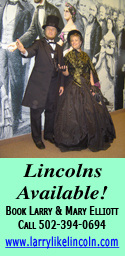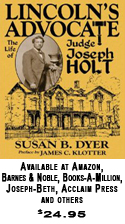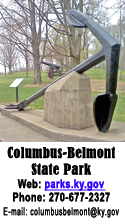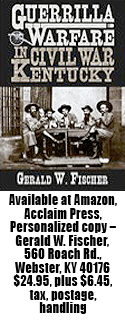|
|
Custer’s time in Elizabethtown was
better than his Montana last stand
George Armstrong Custer always will be best remembered for his ill-fated battle with the Lakota and Cheyenne Indians in Montana.
Custer’s Last Stand earned the New Rumley, Ohio (Harrison County) native a prominent place in U.S. history, but not in the positive manner he desired. His reputation during his two-year assignment in Kentucky – although not as colorful – cast him in a more acceptable light.
The flamboyant Custer was the youngest Civil War brigadier general in the Union Army at age 23, and, by the war’s end, he commanded the 3rd Cavalry Division under Gen. Philip Sheridan. Though he attained the rank of Brevet Major General of Volunteers, Custer’s rank in the Regular Army line was only captain. When the army was reorganized in 1866, he was promoted to lieutenant colonel of the newly formed 7th Cavalry. In 1871, the 7th had been on active duty for five years, engaged in fighting hostile Indians on the western plains.
It was at this time, the federal government began stationing troops in many sections of the South with the intent of controlling activities of the Ku Klux Clan, Carpet Baggers and the distribution of illicit whiskey. This meant breaking up the 7th and stationing portions in various Southern locations. Custer and his wife, Libbie, were located in Elizabethtown with cavalry headquarters established on South Main Street. Horses were kept in adjoining stables and across the street while some members of Company A quartered in the Eagle House on North Main.
When the regiment was ordered west, all the officers were mounted on thoroughbred horses.
The Custers made their home, for a time, in part of the Hill House, which was operated by “Aunt Beck” Hill. The Hill House was in its zenith during the early 1870s when Custer and his command were stationed in Elizabethtown with many higher-ranking officers boarding with Mrs. Hill. The greater part of this building is standing today and is known as the Brown-Pusey Community House. The meals of all the guests were taken in the Hill House dining room.
Custer kept a stable of fine Kentucky thoroughbred horses and a pack of Russian wolfhounds and English staghounds. According to Pvt. John Burkman, there were about 80 dogs by the time they left Elizabethtown. Armstrong was very fond of hunting and he frequently hunted small game and would occasionally go to other sections of Kentucky to hunt deer. Custer probably preferred hunting and horse racing to any other form of recreation.
With no such distraction as the Ku Klux Klan, Custer found time to write articles for the Galaxy, a New York magazine. He also took time to play chess with E-town Judge Quince Johnson. Custer’s presence also added much to local dances and it’s recorded that it was a great social time in Elizabethtown.
The commander made many trips to Louisville and attended a number of political meetings there. On one occasion, Colonel Blanton Duncan made a remark in Custer’s presence that was offensive and Custer immediately slapped Duncan’s face. Friends intervened to prevent any further difficulty.
In October 1871, Custer and part of his command were called to Chicago to aid Gen. Sheridan in military police work following the great fire. They remained there for several months before orders came to return to Elizabethtown.
In January 1872, Gen. Sheridan invited the Grand Duke Alexis of Russia on a buffalo hunt. Buffalo Bill Cody was to be the guide and Custer was assigned the duty of initiating the Duke into the art of buffalo hunting. Apparently the Duke took quite a liking to Custer. Following the hunt, Alexis resumed his tour of the United States and when the Duke’s special train arrived in Louisville, Custer was part of the welcoming committee. The Gault House was the scene of an elaborate dinner and ball held for the Duke. Alexis invited the Custers to accompany his royal party on the tour from Louisville to New Orleans. En route from Louisville, the special train stopped in Elizabethtown and town dignitaries and probably most of the townspeople were there to meet the Duke.
Custer and the 7th were ordered to the Dakota Territory in March 1873. Immediately upon receiving orders, they hurriedly packed and left Elizabethtown on the L&N Railroad bound for Louisville, then on to Memphis. From Memphis, steamers were boarded for transport to Cairo and from there rail and horse carried the 7th to Dakota Territory.
Following her husband’s death at Little Big Horn (June 25, 1876), Mrs. Custer returned to Elizabethtown for a day in 1880. Many friends from her stay in Elizabethtown went to the hotel to see her and offer their condolences.
Custer also made an impression on the residents of Breckinridge County. One of the communities there – Custer – is named in his honor.
|
|
|
Washington found
it’s good to have
war-time friends
May 31, 1862, would not be a favored day for Lt. James B. Washington.
The Battle of Seven Pines, Va., saw the Federals overcome the Confederates and Lt. Washington, an aide-de-camp to the South’s Gen. Joseph Johnston, was among those taken captive.
Washington, a descendant of President George Washington and a native of Baltimore, had graduated from the U.S. Military Academy and had embraced the Confederacy at the outbreak of the Civil War. He received a commission that made him a lieutenant in the Provisional Army of Virginia (PAVA) and subsequently was assigned to Gen. Johnston.
But all was not lost for prisoner Washington. A captain in the U.S. 5th Cavalry – George Armstrong Custer – learned of the Confederate’s fate and requested that Washington be his aide during his time in captivity.
Washington and Custer had been friends and classmates at West Point.
Photographer Matthew Brady happened across the two as they sat reminiscing and took a series of photographs. A colorized version of one of the pictures appears above.
Lt. Washington remained a prisoner-of-war until his exchange on Sept. 21, 1862, at Aiken’s Landing, Va., after which he was assigned as an ordnance officer in Montgomery, Ala. At the close of the war, he became an executive with the Baltimore and Ohio Railroad.
The lieutenant died in Pittsburgh.
|
|

















